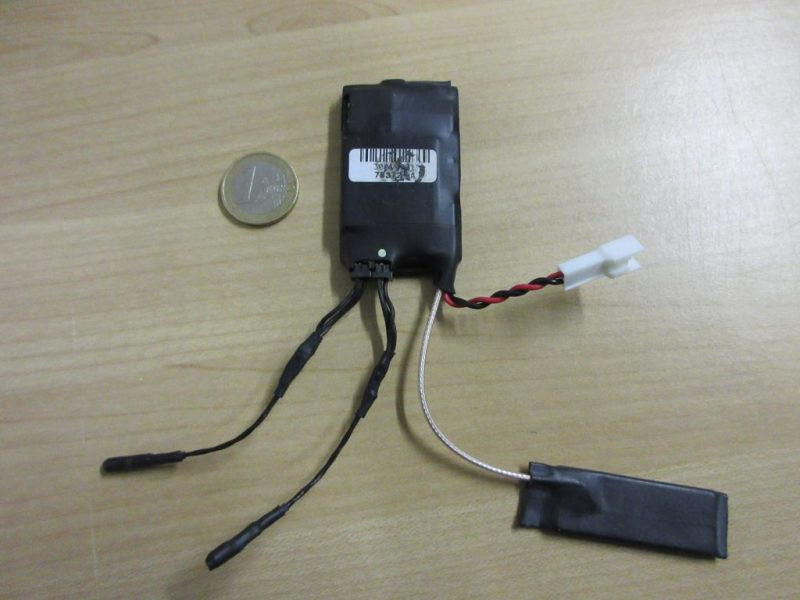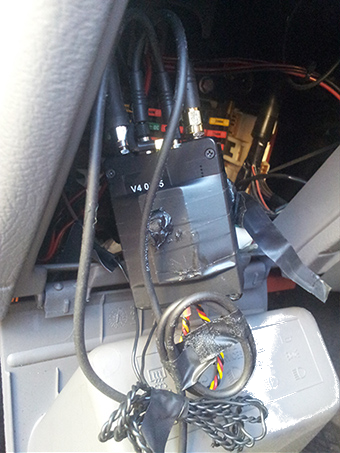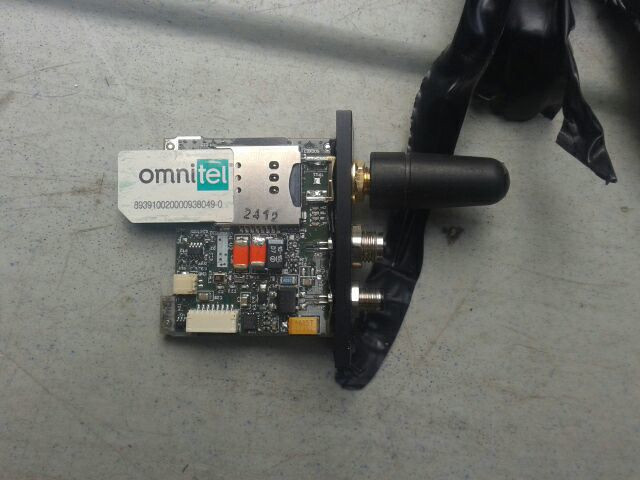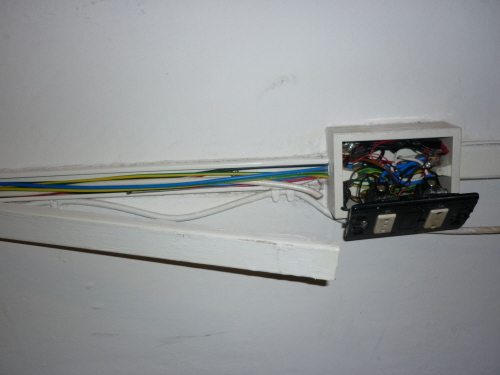The Ears and Eyes project is a searchable database of cases of physical surveillance devices (microphones, cameras, location trackers…) hidden by law enforcement and intelligence agencies to surveil people or groups engaged in subversive activities. Our goal is to help the potential targets of such surveillance practices to better understand and resist them.
Contents
Overview
This section provides a brief overview of the surveillance devices included in the database. It is intended to answer common questions a reader may have about such devices.
When are they installed?

Microphones found inside a power outlet in a building in Bologna, Italy, in January 2018.
Hidden physical surveillance devices are typically used by law enforcement and intelligence agencies to obtain information about a target when traditional surveillance methods are insufficient. For example, if a suspect never talks about sensitive topics on the phone — making the monitoring of their phone useless — law enforcement may resort to installing a hidden microphone in the suspect's home, in the hope of capturing interesting conversations. In many countries, the installation of such devices is regulated by law and must be approved by a judge.
Devices are often installed for long-term surveillance, and may remain in place for weeks, months, or years before being removed or, in some cases, discovered by the people under surveillance. They can also be installed for short-term surveillance of specific events.
Where are they hidden?

Microphones and a GPS tracker found in the fuse box of a car in Lecce, Italy, in December 2017.
In buildings
Microphones and cameras can be installed in buildings to surveil what goes on inside. Such devices have been found:
- Inside objects: electrical outlets, ceiling lights, air vents, power strips, intercom systems and electric meters.
- Inside furniture: an amplifier, a television, a printer and a kitchen hood.
- Behind walls, ceilings, and floors.
Microphones and cameras can also be installed in buildings close to the actual place under surveillance. Typically, they are installed behind windows so that they can monitor the place under surveillance, its main entrance, or the way leading to it.
In vehicles
Microphones and location trackers can be installed in all types of vehicles: cars, trucks, motorcycles, bicycles, etc. Such devices have been found:
- In parts of vehicles that are accessible from the outside: inside a wheel, in a spare wheel bracket, on a rear bumper, behind a horn grid, behind a battery ventilation grid, or inside a bicycle seat. They are sometimes held in place with magnets.
- Inside vehicles: between a car body and its interior coating, inside a car ceiling, in an interior air vent, inside a car seat head, behind a speedometer or inside a fuse box.
Other
Microphones and cameras can also be installed outdoors. Such devices have been found:
- In urban environments: in streets surrounding places under surveillance, including inside a fake electrical box or inside a fake rock.
- In rural environments, hidden in vegetation.
How do they work?

A device equipped with a SIM card found in a vehicle in Italy, in August 2019.
Power supply
Devices require a power supply, which can be either a battery or the electrical system of the building or vehicle in which the device is installed, or both. In rare cases, they may be powered by Power over Ethernet (PoE).
To save battery power and make it harder to detect them, the devices may not be powered on all the time. Some microphones can turn on only when there is sound. Some cameras can use an infrared sensor to turn on only when there is motion. Some location trackers installed on vehicles can turn on only when the vehicle is turned on, or only when it is moving by using a motion sensor.
Data collection
Different devices can collect different kinds of data:
- Microphones can record sound.
- Cameras can record images. Some cameras have infrared vision, allowing them to “see in the dark”.
- Location trackers can record their geographical location. They usually use the Global Positioning System (GPS), allowing them to record their location almost anywhere on the surface of the Earth. In rare cases, deivces equipped with SIM cards can record their own location by connecting to the mobile phone network and using the cell towers they connect to as geographic references.
Data storage
There are two cases:
- Many devices have internal storage, such as an SD card. This allows them to store the collected data so the spies don't have to continuously retrieve it.
- Some devices have no internal storage. They cannot store the collected data, which must be continuously retrieved by the spies, or it will be lost.
Data retrieval
Data collected by a device must be retrieved by the spies at some point. There are several techniques:
- Most devices are equipped with SIM cards, allowing them to send the collected data over the mobile phone network.
- In rare cases, devices are equipped with radio transmitters, allowing them to send the collected data over arbitrary radio frequencies. This technique requires another device, a receiver, to be nearby to receive the signal — the receiver can be hidden in a building or in a vehicle belonging to the spies.
If a device has internal storage, the spies can retrieve its data by physically accessing it.
How to find them?

A dismantled electrical outlet in which a microphone was found, in Lecco, Italy, in October 2010.
First, devices can be found by manually searching for them in the location, vehicle, or outdoor environment suspected to contain hidden surveillance devices. If devices are suspected to have been recently installed, it can be helpful to look for things that are out of place, such as objects or furniture that may have been moved when the devices were installed. It can be helpful to have the right tools, for example to dismantle electrical outlets in a building or to dismantle the interior of a vehicle. If a device is found, it is important not to stop there: there may be others!
Detection devices can be purchased at specialty stores or on the Internet. Such devices include:
- Radio frequency detectors to detect devices that are transmitting data on radio frequencies at the time of detection.
- Camera lens detectors to detect cameras.
Professional equipment — spectrum analyzers, non-linear junction detectors, thermal imaging systems — can be more effective, but is very expensive and complex to use. It is also possible to pay a specialized company to search for hidden devices, but this is also very expensive, and such companies sometimes have strong ties to local authorities.
Methodology
To be included in the database, a case must meet the following conditions:
- A minimum amount of information must be available about the devices, such as where and when they were used, what they looked like, etc. The mere mention of a device in a news article or investigative file is not sufficient.
- The devices must have been installed or operated by a law enforcement or intelligence agency — or by a private company or militia acting as a law enforcement or intelligence agency.
- The devices must have been targeted at individuals or groups engaged in subversive activities. This specifically excludes devices that target government agencies or commercial companies.
- There must be a high likelihood that the case is real and not staged. We assess this likelihood based on our knowledge of how law enforcement and intelligence agencies operate and our experience with subversive networks.
For each case, the following information is provided where possible:
- The type of devices, the location and date they were discovered, and their components.
- Pictures of the devices.
- Additional relevant files, such as user manuals for the devices.
- Sources used to provide this information.

